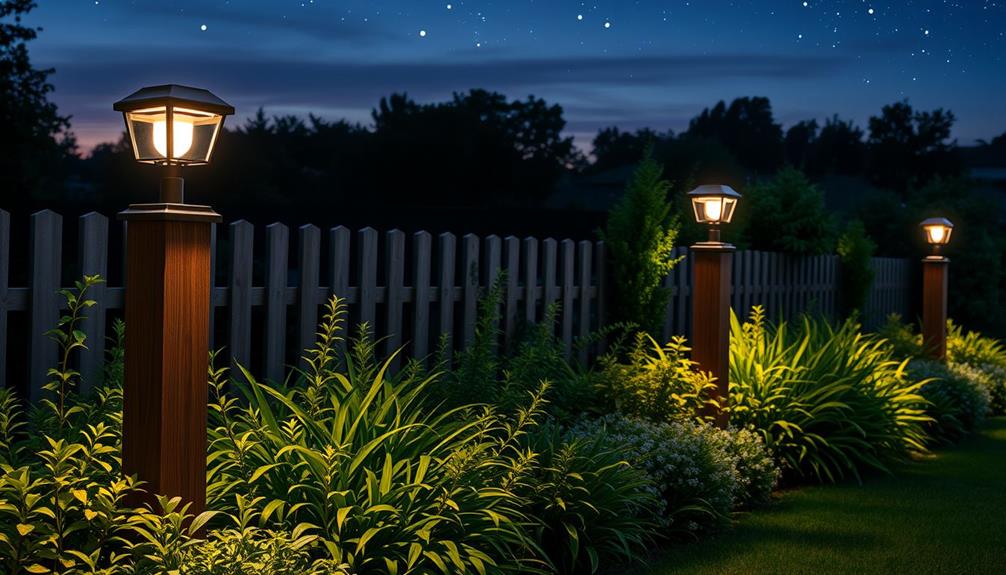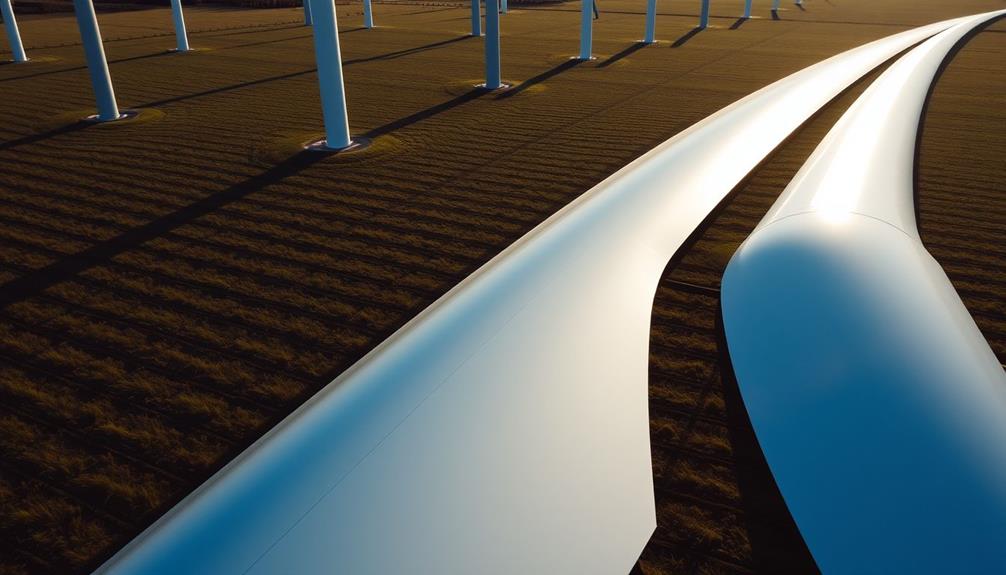Solar fence post lights are an eco-friendly way to brighten up your yard while enhancing its beauty. These lights harness solar energy, reducing your electricity costs and carbon footprint. With options available for various post sizes and dual lighting modes, you'll find the perfect fit for your outdoor space. They're easy to install and weather-resistant, ensuring consistent performance all year long. Plus, you can achieve stunning ambient effects without relying on traditional power sources. If you're curious about finding the right lights and maximizing their benefits, there's plenty more to discover.
Key Takeaways
- Solar fence post lights are powered by renewable energy, reducing reliance on fossil fuels and lowering your carbon footprint.
- These lights offer easy installation without wiring, making them ideal for DIY projects and quick outdoor enhancements.
- With IP65 waterproof ratings, solar lights ensure durability and functionality in various weather conditions year-round.
- Dual brightness modes allow customization of outdoor ambiance, enhancing aesthetic appeal and safety for gatherings.
- Regular maintenance, such as cleaning solar panels, maximizes efficiency and prolongs the lifespan of your solar lights.
Overview of Solar Fence Post Lights
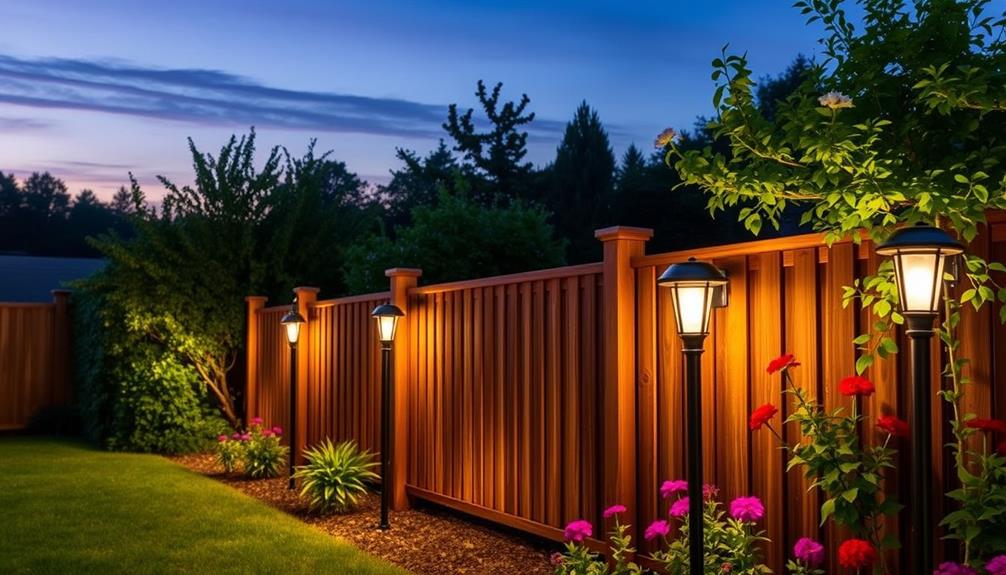
Offering an eco-friendly lighting solution, solar fence post lights are a popular choice for homeowners looking to enhance their outdoor spaces. These fixtures are powered by solar energy, making them a sustainable option that requires no electrical wiring.
Each solar fence post light consists of a solar panel, a rechargeable battery, and an LED light, ensuring you get reliable illumination without added costs. With their ability to harness solar energy, they contribute to reducing carbon footprints, aligning with renewable energy goals. Additionally, oversized solar solutions can enhance energy efficiency in outdoor applications.
With a waterproof rating of IP65, these lights are designed to withstand various weather conditions, including rain, snow, and frost. This durability makes them ideal for year-round outdoor lighting.
They come in multiple design options to fit various post sizes—3.5×3.5, 4×4, 4.5×4.5, and 5×5 inches—allowing you to customize your lighting to suit your space.
Additionally, many models feature dual light modes, offering both warm white and cool white options. This versatility enhances your outdoor ambiance during gatherings and events.
Plus, with their energy efficiency, these lights can charge in just 6-8 hours of sunlight, providing illumination for 10-12 hours at night, considerably reducing your electricity costs.
Benefits of Solar Lighting

Solar lighting provides numerous advantages that make it an appealing choice for outdoor illumination. One of the most significant benefits of solar post lights is their environmentally friendly nature. By harnessing solar power, you reduce reliance on fossil fuels and minimize your carbon footprint. Plus, after installation, you won't face any electricity costs, leading to long-term savings compared to traditional lighting.
Another fantastic aspect is the easy installation. You won't need complex wiring or professional electricians, allowing you to set up your lights quickly. Additionally, many solar lights are designed to withstand various weather conditions with their waterproof solar ratings, guaranteeing durability and functionality year-round.
The bright illumination offered by LED technology enhances outdoor visibility while consuming minimal energy, making these lights both efficient and effective.
Here's a quick overview of the benefits:
| Benefit | Description | Impact |
|---|---|---|
| Eco-Friendly | Uses renewable energy | Reduces carbon footprint |
| Cost-Effective | No electricity costs after installation | Long-term savings |
| Easy Installation | No complex wiring needed | DIY-friendly |
| Weather Resistant | Waterproof solar lights designed for durability | Year-round functionality |
| Bright Illumination | LED technology guarantees effective lighting | Enhances outdoor visibility |
Types of Solar Post Lights
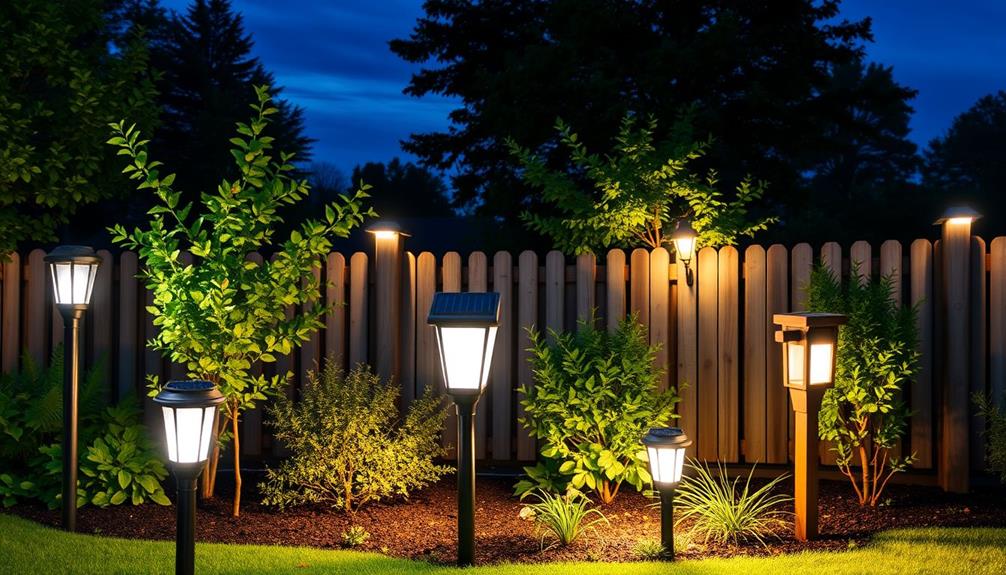
When you're choosing solar post lights, you'll find several types that can elevate your outdoor space.
Solar post cap lights sit atop your posts, adding charm and soft illumination, while deck post lighting options are perfect for patios.
Additionally, selecting options that are best for dust removal can help maintain a clean and inviting atmosphere around your home.
Plus, various fence post light styles can enhance both security and aesthetics along your property lines.
Solar Post Cap Lights
Enhancing your outdoor space is easy with solar post cap lights, which fit neatly atop fence posts to provide both illumination and style.
These lights are designed for easy installation, making them perfect for DIY enthusiasts. You won't need any wiring or extensive tools, so you can enjoy beautiful outdoor lighting without the hassle.
Additionally, incorporating elements of unique home aesthetics can elevate your yard's charm while maintaining functionality.
Here are four fantastic features of solar post cap lights:
- Dual Brightness Modes: Choose between warm white and cool white lighting to set the perfect ambiance.
- Versatile Sizing: Suitable for various post sizes, ranging from 3.5×3.5 to 5×5 inches.
- Eco-Friendly: Enjoy illumination without electricity costs, thanks to solar power.
- Long-Lasting: After just 6-8 hours of sunlight, these lights can illuminate your space for 10-12 hours.
With solar post cap lights, you can enhance your yard's aesthetics while benefiting from reliable, eco-friendly outdoor lighting.
They're not just functional; they also add charm and safety to your outdoor areas.
Go ahead and transform your space with these stylish and practical solutions!
Deck Post Lighting Options
Transforming your deck into an inviting outdoor retreat starts with choosing the right lighting options. Solar deck post lights are a fantastic choice, as they enhance both the aesthetics and functionality of your outdoor space.
With various installation options available, you can easily find fixtures that fit standard deck post sizes like 3.5×3.5, 4×4, 4.5×4.5, and 5×5 inches without the hassle of wiring. Not only do these lights brighten your outdoor areas, but they can also complement your poolside entertaining space with a warm ambiance, perfect for gatherings and relaxation after a day of fun at the DFW water parks.
These lighting fixtures not only provide illumination but also allow you to switch between warm white and cool white light modes, depending on your mood or occasion. Plus, they're built to last. Many solar post lights come with an IP65 waterproof rating, meaning they can withstand diverse weather conditions without compromising performance.
After charging for just 6-8 hours in sunlight, solar deck post lights can illuminate your deck for 10-12 hours, making them an efficient and eco-friendly choice.
Fence Post Light Styles
As you explore the various styles of solar post lights, you'll find that they come in multiple designs tailored for different outdoor applications.
These solar fence post lights not only enhance your yard's aesthetics but also provide illumination without electricity, making them an eco-friendly choice. High-quality, engaging content about content relevance and authority can further educate homeowners on the benefits of solar lighting.
Here are four popular styles you might consider:
- Solar Fence Post Lights: Ideal for illuminating your fence line, these lights offer a warm, welcoming glow.
- Solar Deck Post Lights: Designed for decks and patios, they create a cozy atmosphere for outdoor gatherings.
- Solar Post Cap Lights: These lights fit neatly on top of fence or deck posts, adding a stylish touch while maximizing brightness.
- Dual Brightness Solar Lights: Many options include dual brightness modes, allowing you to switch between warm and cool white illumination.
With a range of mounting options available, you can easily install these lights on various post sizes, including 3.5×3.5, 4×4, 4.5×4.5, and 5×5 inches.
The upgraded clear shades help reduce glare from ultra-bright LEDs, ensuring you enjoy elegant light patterns while enhancing your outdoor lighting experience.
Choosing the Right Solar Lights

When selecting solar lights for your fence posts, it's essential to take into account several key factors to guarantee you make the best choice.
Start by considering the brightness measured in lumens; higher lumens mean better illumination, which enhances safety and visibility at night. You want your yard to be well-lit, so aim for lights that offer a substantial lumen output. Additionally, an effective budgeting plan can help you allocate funds for quality solar lights that meet your needs.
Next, check the weather resistance rating of the solar post lights. Look for a rating of at least IP65 to confirm they can withstand rain, snow, and other outdoor conditions.
Additionally, make sure the lights are compatible with your existing post sizes; many fit 3.5×3.5, 4×4, 4.5×4.5, and 5×5 inch posts, making installation hassle-free.
Don't forget to evaluate the battery capacity. Higher capacity batteries can store more energy, providing longer illumination throughout the night.
Finally, consider choosing lights with dual light modes—like warm white and cool white—to customize the ambiance of your outdoor space according to your preferences.
Installation Tips for Solar Lights

Installing solar fence post lights can greatly enhance the ambiance and safety of your outdoor space, while also contributing to an eco-friendly lifestyle by harnessing renewable energy. Proper setup is essential for best performance; for instance, research indicates that astrology and attractiveness can influence personal choices, such as the aesthetic appeal of your yard.
Follow these tips for an effective installation that maximizes the benefits of your outdoor lights:
- Optimal Placement: Position your lights in areas that receive 6-8 hours of direct sunlight daily. This guarantees the solar panel charges efficiently, providing consistent illumination throughout the night.
- Easy Installation: Use the included screws for a quick and easy installation on various post sizes, including 3.5×3.5, 4×4, 4.5×4.5, and 5×5 inch vinyl and wooden posts.
- Spacing: Space the lights appropriately to prevent overlapping light circles. This way, you'll achieve effective coverage across your yard, enhancing safety and aesthetics.
- Secure Attachment: Make sure to attach the lights securely to withstand wind and weather conditions. Always follow the manufacturer's guidelines for installation to guarantee longevity and performance.
Enhancing Your Outdoor Aesthetics

When you choose solar fence post lights, you're not just lighting up your space; you're elevating its style.
Incorporating these lights can beautifully complement your outdoor decor, especially when paired with modern farmhouse decor trends that emphasize natural materials and neutral palettes.
With a variety of elegant designs and finishes, you can easily find options that fit your outdoor decor.
Plus, their customizable installation lets you create the perfect ambient lighting effects for any occasion.
Elegant Design Options
Elevate your outdoor space with the elegant design options offered by solar fence post lights.
These stylish fixtures not only provide illumination but also enhance the overall aesthetics of your yard, creating a harmonious blend of beauty and functionality.
With their upgraded clear shade, they create beautiful patterns while reducing glare from ultra-bright LEDs, ensuring a lovely ambiance without sacrificing elegance.
Mood boards essential for visualizing design concepts can help you envision how these lights will transform your outdoor area.
Here are some features that make these solar lamp post lights a fantastic addition to your outdoor decor:
- Customizable Lighting Options: Choose between warm white and cool white light modes to suit any occasion.
- Versatile Sizing: Designed to fit various post sizes (3.5×3.5, 4×4, 4.5×4.5, and 5×5 inches), these lights blend seamlessly with your existing structures.
- Durable Design: Made from high-quality ABS plastic, these lights maintain an elegant appearance and can withstand the elements for lasting beauty.
- High Customer Satisfaction: With an average rating of 4.0 stars, users appreciate both the aesthetic appeal and easy installation.
Transform your yard into a stylish and inviting space with these elegant solar fence post lights!
Ambient Lighting Effects
Solar fence post lights not only enhance your outdoor aesthetics with their elegant designs but also create enchanting ambient lighting effects. With upgraded clear shades that minimize glare from ultra-bright LEDs, these lights cast beautiful patterns, elevating your outdoor space's ambiance. You can choose between warm white and cool white light modes, allowing you to tailor the atmosphere for any occasion, whether it's a festive gathering or a quiet evening.
Here's a quick overview of the benefits of solar fence post lights:
| Feature | Benefit |
|---|---|
| Light Modes | Customizable ambiance for various occasions |
| Design Compatibility | Fits multiple post sizes (3.5×3.5 to 5×5 inches) |
| Weather Resistance | IP65 rating guarantees durability in all conditions |
| Eco-Friendly | Reduces electricity costs and promotes sustainability |
Customizable Installation Choices
Customizable installation choices make it easy for you to enhance your outdoor aesthetics with solar fence post lights.
Whether you have vinyl or wooden posts, these lights fit various sizes, including 3.5×3.5, 4×4, 4.5×4.5, and 5×5 inches. This flexibility allows you to tailor the installation based on your specific setup, ensuring a seamless integration into your yard.
Additionally, incorporating these lights can create a warm and inviting atmosphere that complements outdoor activities like hiking, fishing, and wildlife observation.
Here are four ways to maximize your solar lights' impact:
- Choose Your Light Mode: Select between warm white and cool white light to set the perfect mood for different occasions.
- Strategic Placement: Position lights along pathways, fences, or patios to create a cohesive and inviting design.
- Reduce Glare: The upgraded clear shade minimizes glare from the ultra-bright LEDs, creating elegant nighttime patterns that enhance visual appeal.
- Weather-Resistant Durability: With an IP65 rating, these lights withstand various weather conditions, maintaining their functionality and style.
Maintenance for Longevity
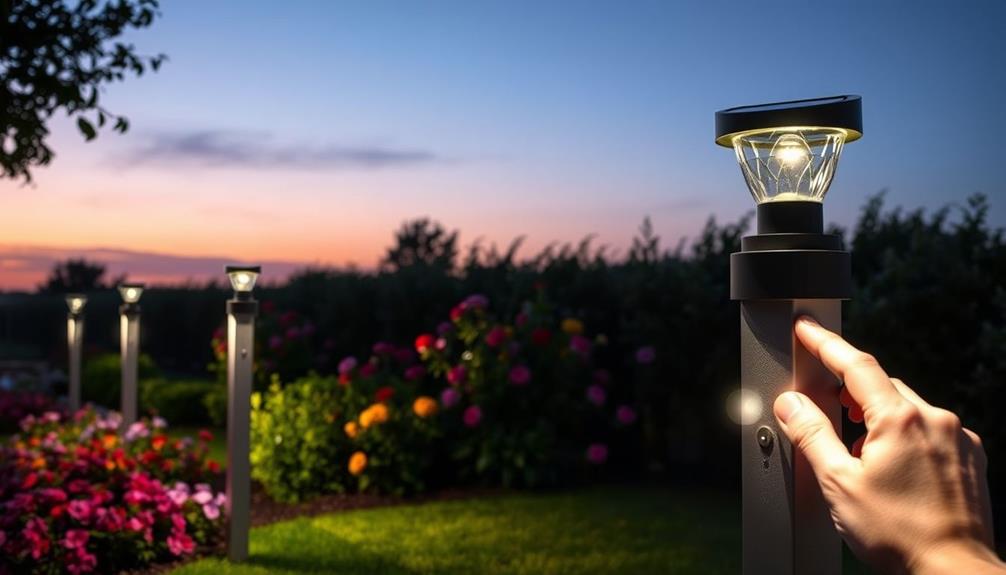
To keep your fence post lights shining brightly for years, regular maintenance is vital. Start by cleaning the solar panels frequently to remove dirt and debris. This guarantees maximum sunlight absorption and ideal charging efficiency, which is essential for longevity.
Next, inspect the lights periodically for any signs of damage or wear. Address issues like loose fittings or cracked plastic immediately to prevent further deterioration.
Don't forget to check the rechargeable batteries annually. They may need replacement after a few years to maintain a consistent illumination duration of 10-12 hours each night.
Confirm that the area around your installation stays clear of overhanging branches or foliage that could block sunlight from reaching the solar panels.
During extreme weather conditions, such as heavy snow or ice storms, store your lights indoors. This simple step not only prolongs their lifespan but also helps maintain their aesthetic appeal.
Comparing Product Options
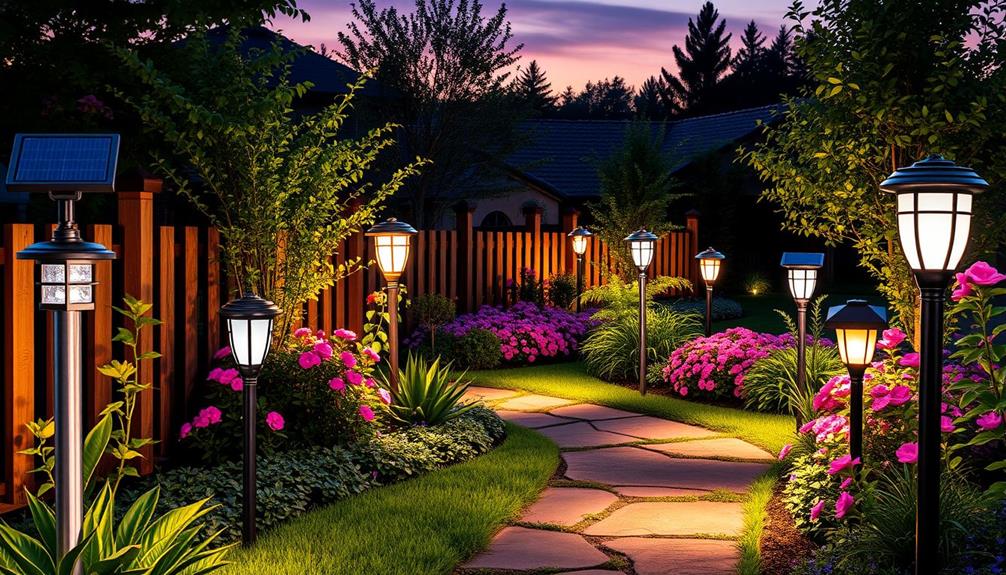
When choosing the right fence post lights for your outdoor space, you'll find a variety of options that cater to different needs and budgets.
Here's a quick comparison of some popular solar-powered fence post lights:
- Classy Caps Kingsbridge Dual Lighted Solar Post Cap Lights – Priced at $36.99, these lights offer dual brightness modes, ensuring you get the perfect illumination without compromising style.
- Cambridge Aluminum 6×6 Solar Post Cap Lights – Available in a 2 Count pack for $69.99, these durable lights are ideal for larger fence posts, providing sturdy construction and effective outdoor solar illumination.
- Colonial Solar Powered Fence Post Caps – At $62.99, these caps feature a classic design that enhances your outdoor aesthetics while delivering reliable lighting.
- Summit Solar Chain Link Fence Cap Lights – For those on a budget, these lights retail for $34.99 for a 2 Pack, offering an affordable way to enhance your chain link fencing.
No matter which option you choose, each product adds a touch of elegance to your yard, combining functionality and style for your outdoor space.
Eco-Friendly Lighting Solutions

Many homeowners are increasingly turning to eco-friendly lighting solutions, and solar fence post lights stand out as a top choice. These lights harness renewable solar energy, drastically reducing reliance on fossil fuels and lowering your carbon footprint. In addition to their environmental benefits, solar fence post lights also offer practical advantages. They are easy to install and require minimal maintenance, making them a convenient and cost-effective lighting solution for outdoor spaces. With advancements in technology, solar fence post lights now come in a variety of styles and brightness levels, allowing homeowners to customize their outdoor lighting to suit their preferences and needs.
With an average charging time of just 6-8 hours of sunlight, they can shine brightly for 10-12 hours at night, providing reliable illumination without the need for electricity.
By choosing solar-powered lights, you eliminate electricity costs, leading to significant long-term savings on your energy bills. Plus, many models come equipped with a waterproof rating of IP65, ensuring they can endure harsh weather conditions while maintaining their eco-friendly functionality.
Designed with high-quality materials like ABS plastic, solar fence post lights are built for durability, minimizing waste from frequent replacements. This commitment to sustainable practices not only benefits your wallet but also helps protect the environment.
Embracing solar lighting is a smart decision that enhances your yard's appeal while supporting a healthier planet. So why not make the switch today? You'll enjoy the beauty of your outdoor space without compromising on eco-friendliness.
Frequently Asked Questions
Are Solar Post Lights Worth It?
If you're considering solar post lights, they're definitely worth it! They save you money on electricity, require minimal maintenance, and offer reliable lighting. Plus, their easy installation makes them a convenient choice for your outdoor spaces.
What Are the Disadvantages of Solar Outdoor Lights?
When considering solar outdoor lights, you'll find some disadvantages. They can struggle during cloudy weather, emit lower brightness, have limited battery life, and require careful placement and maintenance to guarantee peak performance and longevity.
How Long Do Solar Fence Lights Last?
Solar fence lights typically last around 10-12 hours on a full charge. With proper maintenance, including battery checks and cleaning, you can enjoy their illumination for 5-10 years before needing replacements.
How Do You Activate Solar Lights in a Yard?
To activate solar lights in your yard, place them in direct sunlight for 6-8 hours, turn the switch on, and guarantee the solar panels are clean. Check batteries if they don't illuminate.
Conclusion
In choosing solar fence post lights, you're not just illuminating your yard; you're embracing a lifestyle that values sustainability. Each post light you install reflects a commitment to eco-friendliness, transforming your space while protecting the planet. You might find it coincidental that as you enhance your outdoor aesthetics, you're also contributing to a brighter future. So go ahead, light up your yard and let your choices shine as a beacon of environmental responsibility!
